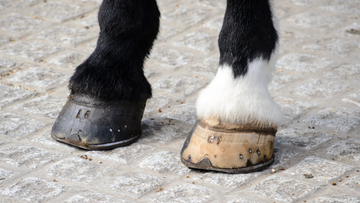What is a Navicular?
The navicular bone is a tiny bone in the hoof of your horse. Navicular disease, also known as navicular syndrome, is a degenerative disease that affects the navicular bone. Overall, navicular disease can affect any horse regardless of breed or age. It will cause significant lameness.
Despite its size, the navicular bone plays a huge role in your horse’s ability to move. After all, the navicular bone is a shock absorber for the rest of the leg. Damage and disease to this bone can cause lameness and significant pain.
Causes of Navicular Disease
While the exact cause of navicular disease is unknown, many factors contribute to the development of this disease. Genetic factors, such as breed and the environment and lifestyle of your horse, are the most significant contributors. A horse’s environment can have a lot of impact on his body. Improper shoeing, overuse/over-exercise, and trauma can all cause issues with the navicular bone.
Life Expectancy with Navicular Disease
 According to some studies, the average lifespan for a horse diagnosed with navicular disease is 14 years. Those suffering from milder cases can live into their twenties. Both ages are far younger than the average lifespan of a horse. The greatest impacts are the severity of the injury and the age at which the horse develops this disease.
According to some studies, the average lifespan for a horse diagnosed with navicular disease is 14 years. Those suffering from milder cases can live into their twenties. Both ages are far younger than the average lifespan of a horse. The greatest impacts are the severity of the injury and the age at which the horse develops this disease.
Symptoms and Diagnosis
Common Symptoms
Navicular disease develops over time. Some of the symptoms seem like a sign of aging or over-exercise. Altogether, here is a list of symptoms to look out for:
- Gradual onset of lameness
- Shortened stride
- Disinterest in moving
- Standing with hindlegs more central to the body
- Picking up specific feet
Diagnostic Procedures
With no definitive test, navicular disease can be challenging to diagnose. However, a skilled veterinarian can use your observations and some diagnostic tests to reach a diagnosis. These tests include X-rays, ultrasounds, nerve blocks, and MRIs.
Management and Treatment
Pain Management Strategies
To best help your horse with navicular disease, you will want to help him manage his pain and inflammation. Your veterinarian may prescribe anti-inflammatory drugs or corticosteroids to help with this issue.
Exercise
A carefully balanced exercise plan may help your horse hold off lameness for as long as possible. Low-impact exercise will allow your horse to build muscle with less pain. Additionally, weight management is key to this disease. Lack of exercise will cause weight gain and speed up the degeneration of navicular disease.
Surgical Treatments
There are some surgical options for some horses. One option is a neurectomy to remove a small part of the nerve supporting the navicular bone. It will stop the pain immediately but can have severe long-term effects. Also, there is a surgery to cut the tendon controlling the bone. Like the neurectomy, it will reduce pain but has other side effects that can be troublesome.
Role of Trimming in Managing Navicular Disease
Corrective shoeing can reduce the pain and stress on the hoof. Foot care is vital for long-term relief from navicular disease. Specialized shoes such as wedge and eggbar shoes will help your horse.






















